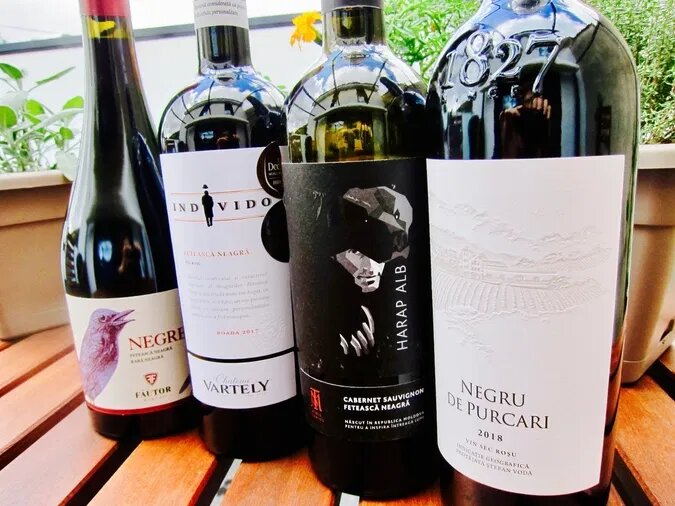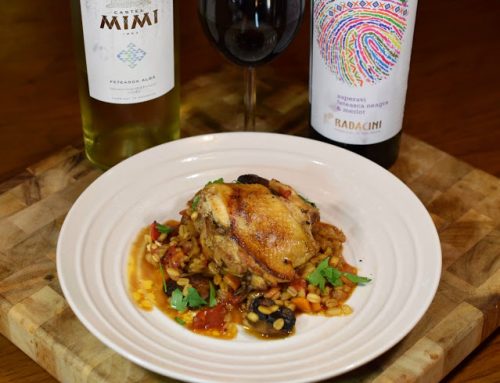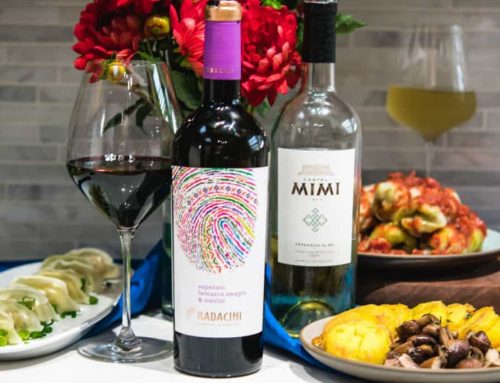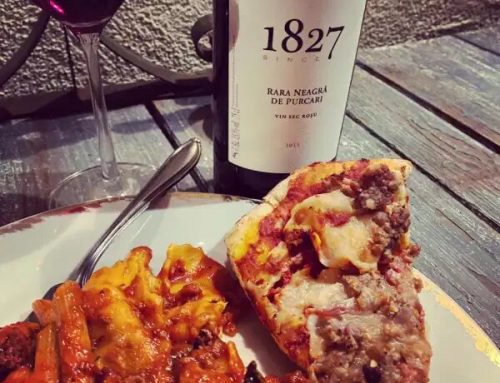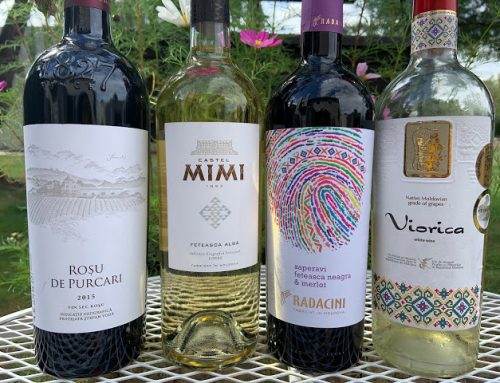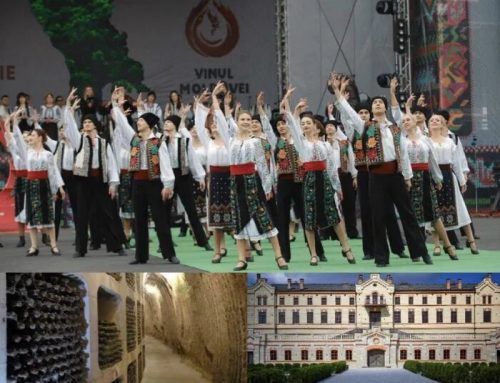Since the iron curtain fell, Moldovan wineries and vineyards are back to private ownership, viticulture is evolving, and Moldova is welcoming visitors in droves to share and enjoy their wines.
In fact, efforts to decrease quantity and increase quality are forefront and center. And Moldova highlights less know grapes native to the country for those seeking the obscure. Ready to come with me and discover Moldovan wine?!?
~ ~ ~ ~ ~
I jumped at the chance to celebrate Moldova’s National Wine Day with the new blogging group, World Wine Travel and Wine of Moldova. We’ll be on Twitter chatting this Sunday, October 4th at 11am ET and 5pm in France using hashtags #WorldWineTravel and #MoldovaWineDay. Hope you’ll join us!
If you missed the Moldova wine Master Class led by wine judge and wine writer Dr. Jamie Goode on October 3rd you can see the recording of it here.
The consistent theme of the sponsored wines I received revolves around two grapes: Fetească Neagră and Rara Neagră, each wine is between 5% and 100%. Fetească Neagră (pronounced Fet-YA-sca NA-Gra) is hard to say five times fast yet definitely memorable on the palate!
All About the Grapes
Winemakers in Moldova are working with grapes both familiar (Cabernet Sauvignon, Merlot, Pinot Noir, Chardonnay, Sauvignon Blanc) and obscure (Fetească Neagră, Fetească Regala, Fetească Albă, Viorica, Plavai, and Rkatsiteli). International varieties hold substantial ground yet I find these less known varieties exciting.
My Kindle version of the Jancis Robinson book Wine Grapes came in handy for these grapes where it shares the black Fetească Neagră “…probably originates in the historical region of Moldavia (including today’s Republic of Moldova and the Romanian region of Moldova)”. It’s rarely found outside of Eastern Europe but that may change as less common grapes become more and more popular.
And for Rară Neagră, also known as Băbească Neagră, it tells us the grape “…is a very old Romanian variety that most likely originated in the Nicoreşti vineyards in the county of Galaţi in Romanian Moldova…”
Clusters of Feteasca Neagra, a thick-skinned red grape indigenous to Moldova and Romania. The grape has characteristic blackberry aromas.
Pertaining to Fetească Neagră, other sources shared it is resistant to both drought conditions and cold temperatures. This strength could come from its thicker skins, which also means higher concentrations of anthocyanin and deep ruby red colors.
It grows vigorously yet contradicts itself with low productivity. The grape makes up for it being flexible, producing dry, semi-dry and sweet wines.
Pertaining to Rară Neagră, the grape is almost opposite having thin skins, susceptible to noble rot, powdery and downy mildews, and doesn’t like drought conditions.
All this leads us to the best part, tasting wines made with these two grapes! (For an overview of Moldovan wine and wine regions see my previous article here.) The wines in this article were provided as samples, no other compensation was provided. All thoughts and opinions are my own.
 2019 Minis Terrios Harap Alb
2019 Minis Terrios Harap Alb
Minis Terrios is a family owned and operated smaller winery established in 2013. This is the third wine Dan Prisacaru (who studied in Burgundy) made with the label highlighting a fairy tale character. Here Harap Alb (the white moor or white and black person) gave him the idea to make a white wine from dark berries. This character is often seen slaying a bear, thus the bear hat he wears as shown on the label.
Prisacaru blended Cabernet Sauvignon (85%) and Fetească Neagră (15%) in the blanc de noir style.
Aged for two months with batonnage (lees stirring), the color is pale coppery-pink. Lifted aromas include rose, yellow plum, citrus (the pith of lemon and lime), celeriac, hints of cider-like red berries. The palate is very different with a citrus astringency, less ripe nectarine and apricot kernel focus. It’s zesty with refreshing acidity and a low tannic feel that made me wonder if there was a bit of skin contact, however and exchange with Dan confirmed no.
Overall the wine has a savory quality and a lean, crisp texture that paired wonderfully with my udon noodle dish. Buckwheat udon and vegetables in a Asian sesame sauce topped with poached egg and algue pesto. The rich sesame tamed the astringency and highlighted the nectarine flavors in the wine. 13% ABV, average price in the EU $8
Minis Terrios is on FaceBook!
2017 Chateau Vartely | Individo
The chateau is a winery and leisure resort with guesthouses, a restaurant and fireside lounge. They offer a number of varied wine tours and tastings.
Individo is Vartely’s line of single variety wines. Being 100% Fetească Neagră which is known for a deep color, it poured a lighter ruby than expected. The wine delivers big on aromas: black berry, black plum, cherry, faint chocolate (which reminded me of Nestle’s Quick) and lightly toasted wood. These carried to the palate, also pronounced yet with fresher fruit, cedar and forest spices. The balanced acidity and finely integrated tannins played off each other allowing flavors to linger.
Not knowing a lot about this grape we pulled out the grill deciding on Steak-Frites. This classic French dish featuring entrecote (rib-eye) was a super pairing. Here the richness of the meat toned down the tangier fruit flavors, highlighted the spices in the wine and gave it even more of a silky feel. And those crispy, smoky fries cooked on the grill… amazing too! Visit the Chateau Vartely website for more information. 14% ABV, average price $22
2018 Chateau Purcari |Negru De Purcari
Purcari is one of the oldest wineries in Moldova with a fascinating story. They received a special edict from Tzar Nicholas I in 1827 indicating them the first specialized winery in Bessarabia. They survived wars and the Soviets and remain a top Moldovan source for wines today. Negru De Purcari is an original wine that is still made today.
Purcari’s vineyards nestle in their own micro-climate and receive warm winds off the Black Sea which aide grape ripen during the summer months into autumn.
 In this wine, the 55% Cabernet Sauvignon, 40% Saperavi and 5% Rara Neagră spent 18 months in French oak barrels. Note Rara Neagră goes by Băbească Neagră in Romania.
In this wine, the 55% Cabernet Sauvignon, 40% Saperavi and 5% Rara Neagră spent 18 months in French oak barrels. Note Rara Neagră goes by Băbească Neagră in Romania.
Color: Almost pronounced, really beautiful ruby-purple.
Aromas: Medium-intensity ripe red and black plum, black cherry, blackberry, non-sweet bubblegum, forest spice.
Palate: The berries follow to the palate but riper; fresh green peppercorn, cedar, vanilla and clove. It’s dry yet has a sweetness to it from the fruit.
The attack is quite fresh and round then subsides into a bowl of fruit and spice with the peppercorns squeezed over the top. Medium acidity and body with impeccable balance, the tannins are silky and fade as the wine lingers. One rich and elegant pour.
I used my Coravin to taste this wine with the steak-frites too. While I would sip it alone, the richness of the beef relaxed the high tones of the wine making it that much more enjoyable.
I pulled the cork the following day. After an hour, sipping it with home made pizza our conclusion- a very nice wine! Visit the Purcari Winery website for additional information. 14% ABV, average price $22
Fautor Winery – Negre 2017
Fautor Winery Limited Edition labels have stories behind them. Here, the label frame is separated by a swallow and a swallow’s tail. Feteasca Neagra is also known as the swallow’s tail or ‘coada randunicii‘.
Negre is in Fautor’s Limited Edition range of wines. Here they highlight two Moldovan grapes, Fetească Neagră (51%) and Rară Neagră (49%) grown en the Valul lui Traian appellation.
The wine spent 12 months in new French oak barrels before release.
This medium-ruby colored, medium-bodied wine is wild berry forest fresh with red and black cherry, hints of pine, cinnamon, clove, vanilla and shaved wood. An appealing earthiness on the palate, fruit flavors are fresher- red and black cherry, black berry, then bay spice and cedar. Tannins taste younger with a tacky feel that fades quickly allowing the fruit, round silkiness and balanced structure to shine. I would invite a pairing of grilled duck breast with roasted chestnuts and mushrooms topped with a chunky cherry sauce to my table!
14% ABV, average price $23 For more information about Fautor Winery visit their website.
In wrapping up this Moldovan wine foray, I reiterate my research highlights- Moldova is making high quality wines of character worthy of a place at your table. I hope you’re able to enjoy a glass soon!
Posted by Lynn at Savor the Harvest

